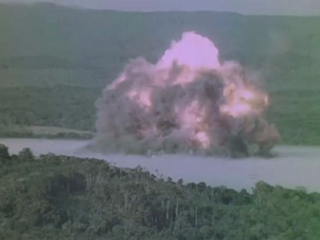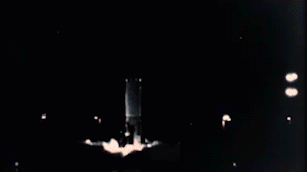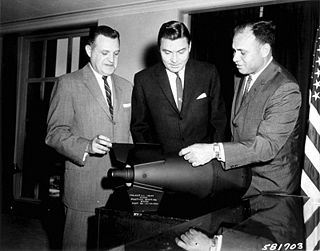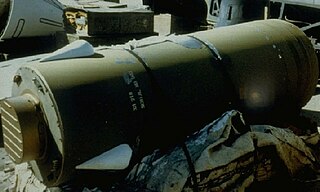
Operation Argus was a series of United States low-yield, high-altitude nuclear weapons tests and missile tests secretly conducted from 27 August to 9 September 1958 over the South Atlantic Ocean. The tests were performed by the Defense Nuclear Agency.

The M28 or M29 Davy Crockett Weapon System was a tactical nuclear recoilless smoothbore gun for firing the M388 nuclear projectile, armed with the W54 nuclear warhead, that was deployed by the United States during the Cold War. It was the first project assigned to the United States Army Weapon Command in Rock Island, Illinois. It remains one of the smallest nuclear weapon systems ever built, incorporating a warhead with yields of 10 to 20 tonnes TNT equivalent. It is named after American folk hero, soldier, and congressman Davy Crockett.

Operation Upshot–Knothole was a series of eleven nuclear test shots conducted in 1953 at the Nevada Test Site. It followed Operation Ivy and preceded Operation Castle.

Operation Plumbbob was a series of nuclear tests that were conducted between May 28 and October 7, 1957, at the Nevada Test Site, following Project 57, and preceding Project 58/58A.

The B83 is a variable-yield thermonuclear gravity bomb developed by the United States in the late 1970s that entered service in 1983. With a maximum yield of 1.2 megatonnes of TNT (5.0 PJ), it has been the most powerful nuclear weapon in the United States nuclear arsenal since October 25, 2011 after retirement of the B53. It was designed by Lawrence Livermore National Laboratory.

Operation Blowdown was an explosives test carried out in the Kutini-Payamu jungle of Australia's Cape York Peninsula in 1963, to simulate the effects of a nuclear weapon on tropical rainforest. It was conducted by the Australian Army, the Department of Supply, and the Defence Standards Laboratory with participation from the United Kingdom, Canada and United States. In addition, blast effects on military material, field fortifications, supply points, and foot and vehicle movement were examined in a rainforest environment.

Operation Hardtack I was a series of 35 nuclear tests conducted by the United States from April 28 to August 18 in 1958 at the Pacific Proving Grounds. At the time of testing, the Operation Hardtack I test series included more nuclear detonations than the total of prior nuclear explosions in the Pacific Ocean. These tests followed the Project 58/58A series, which occurred from 1957 December 6 to 1958, March 14, and preceded the Operation Argus series, which took place in 1958 from August 27 to September 6.

Storax Sedan was a shallow underground nuclear test conducted in Area 10 of Yucca Flat at the Nevada National Security Site on July 6, 1962, as part of Operation Plowshare, a program to investigate the use of nuclear weapons for mining, cratering, and other civilian purposes. The radioactive fallout from the test contaminated more US residents than any other nuclear test. The Sedan Crater is the largest human-made crater in the United States and is listed on the National Register of Historic Places.

The W54 was a tactical nuclear warhead developed by the United States in the late 1950s. The weapon is notable for being the smallest nuclear weapon in both weight and yield to have entered US service. It was a compact implosion device containing plutonium-239 as its fissile material, and in its various versions and mods it had a yield of 10 to 1,000 tons of TNT.

Starfish Prime was a high-altitude nuclear test conducted by the United States, a joint effort of the Atomic Energy Commission (AEC) and the Defense Atomic Support Agency. It was launched from Johnston Atoll on July 9, 1962, and was the largest nuclear test conducted in outer space, and one of five conducted by the US in space.

Operation Fishbowl was a series of high-altitude nuclear tests in 1962 that were carried out by the United States as a part of the larger Operation Dominic nuclear test program.

Mark 7 "Thor" was the first tactical fission bomb adopted by US armed forces. It was also the first weapon to be delivered via toss bombing with the help of the low-altitude bombing system (LABS). The weapon was tested in Operation Buster-Jangle. The Mark 7 was fitted with retractable stabilizer fins so it could be carried under fighter-bomber aircraft. The Mark 7 warhead (W7) also formed the basis of the 30.5 inches (775 mm) BOAR rocket, the Mark 90 Betty nuclear depth charge, MGR-1 Honest John rocket, MGM-5 Corporal ballistic missile, and Nike Ajax surface-to-air missile. It was also supplied for delivery by Royal Air Force Canberra aircraft assigned to NATO in Germany under the command of SACEUR. This was done under the auspices of Project E, an agreement between the United States and the UK on the RAF carriage of US nuclear weapons. In UK use it was designated 1,650 lb. H.E. M.C. The Mark 7 was in service from 1952 to 1967(8) with 1,700–1,800 having been built.

The explosive yield of a nuclear weapon is the amount of energy released such as blast, thermal, and nuclear radiation, when that particular nuclear weapon is detonated, usually expressed as a TNT equivalent (the standardized equivalent mass of trinitrotoluene which, if detonated, would produce the same energy discharge), either in kilotonnes (kt—thousands of tonnes of TNT), in megatonnes (Mt—millions of tonnes of TNT), or sometimes in terajoules (TJ). An explosive yield of one terajoule is equal to 0.239 kilotonnes of TNT. Because the accuracy of any measurement of the energy released by TNT has always been problematic, the conventional definition is that one kilotonne of TNT is held simply to be equivalent to 1012 calories.

The W71 nuclear warhead was a US thermonuclear warhead developed at Lawrence Livermore National Laboratory in California and deployed on the LIM-49A Spartan missile, a component of the Safeguard Program, an anti-ballistic missile (ABM) defense system briefly deployed by the US in the 1970s.

The W33 was an American nuclear artillery shell designed for use in the 8-inch (203 mm) M110 howitzer and M115 howitzer.

Upshot–Knothole Grable was a nuclear weapons test conducted by the United States as part of Operation Upshot–Knothole. Detonation of the nuclear weapon, a W9 warhead, occurred 19 seconds after its deployment at 8:30am PDT on May 25, 1953, in Area 5 of the Nevada Test Site.

Operation Sunbeam was a series of four nuclear tests conducted at the United States's Nevada Test Site in 1962. Operation Sunbeam tested tactical nuclear warheads; the most notable was the Davy Crockett.

Operation Dominic was a series of 31 nuclear test explosions ("shots") with a 38.1 Mt (159 PJ) total yield conducted in 1962 by the United States in the Pacific. This test series was scheduled quickly, in order to respond in kind to the Soviet resumption of testing after the tacit 1958–1961 test moratorium. Most of these shots were conducted with free fall bombs dropped from B-52 bomber aircraft. Twenty of these shots were to test new weapons designs; six to test weapons effects; and several shots to confirm the reliability of existing weapons. The Thor missile was also used to lift warheads into near-space to conduct high-altitude nuclear explosion tests; these shots were collectively called Operation Fishbowl.

Operation Prairie Flat was a test involving the detonation of a 500-short-ton (450 t) spherical surface charge of TNT to evaluate airblast, ground shock and thermal effects of nuclear weapons.



















